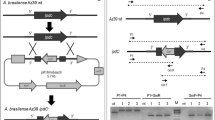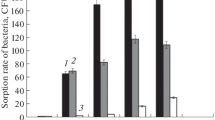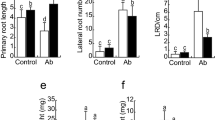Abstract
Rice seedlings developed nodule-like tumors (para-nodules) along primary and secondary roots when treated with the auxin 2,4-dichlor-phenoxy-acetic acid (2,4-D). Histologically, these tumors appeared as cancerous out-grown lateral-root primordes and were thus comparable with stem nodules of the legume Sesbania rostrata. Azorhizobium caulinodans (a diazotroph known as a specific endophyte of Sesbania rostrata) was introduced and became established inside rice para-nodules and in root tissues around tumor bases. The infection with A. caulinodans followed a typical “crack-entry” invasion at places where paranodule tumors had emerged through the root cortex and epidermis. The bacteria settled with high cell densities in intercellular spaces of the induced tumors and between root cortical cells. Infection of plant cells took place both in the epidermis and in cortical tissue. Intracellularly established A. caulinodans was found inside the cytoplasm, surrounded by membrane-like structures. N2 fixation by tumor-inhabiting Azorhizobium sp. was increased at low O2 tensions (1.5–3 kPa) compared with an untreated control. Only a little activity remained at O2 tensions of 5 kPa and above. The present results confirm that root-tumor induction offers a suitable method of establishing diazotrophs endophytically in the roots of gramineous crops.
Similar content being viewed by others
References
Bali A, Blanco G, Hill S, Kennedy C (1992) Excretion of ammonium by a nifL mutant of Azotobacter vinelandii fixing nitrogen. Appl Environ Microbiol 58:1711–1718
Becker M, Ladha JK, Ottow JCG (1990) Growth and N2-fixation of two stem nodulating legumes and their effect as green manure on lowland rice. Soil Biol Biochem 22:1109–1119
Becker M, Diekmann KH, Ladha JK, De Datta SK, Ottow JCG (1991) Effect of NPK on growth and nitrogen fixation of Sesbania nostrata as a green manure for lowland rice (Oryza sativa L.). Plant and Soil 132:149–158
Bender GL, Preston L, Bernard D, Rolfe BG (1988) Formation of nodule-like structures on the roots of the non-legumes rice and wheat. In: Gresskoff PM, Roith G, Stacey G, Newton WE (eds) Nitrogen fixation: Achievements and objectives. Chapman and Hall, New York, p 825
Buresh RJ, De Datta SK (1991) Nitrogen dynamics and management in rice legume cropping systems. Adv Agron 45:1–59
Caetano-Anolès G, Crist-Esters DK, Bauer WD (1988) Chemotaxis of Rhizobium melelotito to the plant flavone luteolin requires functional nodulation genes. J Bacteriol 170:3164–3169
Chen TW, Scherer S, Boger P (1992) Nitrogen fixation of Azorhizobium in artificially induced root para-nodules in wheat. Sci Chína (Ser B) 35:1463–1470
Christiansen-Weniger C (1992) N2-fixation by ammonium excreting Azospirillum brasilense in auxin induced root tumours of wheat (Triticum aestivum L.). Biol Fertil Soils 13:165–172
Christiansen-Weniger C (1995) Para-nodule induction in maize with indole-acetic acid (IAA) and its infection with ammonia excreting Azospirillum brasilense. In: Hegazi (ed) Proceedings of the Sixth International Symposium on Nitrogen Fixation with Non-Legumes. Kluver Academic Publishers, Dordrecht, in press
Christiansen-Weniger C, Vanderleyden J (1994) Ammonia excreting Azospirillum sp. become intracellularly established in maize (Zea mays) para-nodules. Biol Fertil Soils 17:1–8
Christiansen-Weniger C, Van Veen JA (1991) NH +4 excreting Azospirillum brasilense mutants enhance the nitrogen supply of a wheat host. Appl Environ Microbiol 57:3006–3012
De Bruijn FJ (1989) The unusual symbiosis between the diazotrophic stem-nodulating bacterium Azorhizobium caulinodans ORS571 and its host the tropical legume Sesbania rostrata. In: Kosuge T, Nester EW (eds) Plant-microbe interactions. McGraw Hill, New York, pp 457–493
Gebhard C, Turner GL, Gibson AH, Dreyfus BL, Bergersen FJ (1984) Nitrogen-fixing growth in continous culture of a strain of Rhizobium sp. isolated from stem nodules on Sesbania rostrata. J Gen Microbiol 130:843–848
Gulash M, Ames P, LaRosiliere RC, Bergman K (1984) Rhizobia are attracted to localized sites on legume roots. Appl Environ Microbiol 48:149–152
Huang JS (1986) Ultrastructure of bacterial penetration in plants. Annu Rev Phytopathol 24:141–157
Huang SZ, Jia DW (1994) Induction of nodulation on the roots of non-legume rice. In: Nie YF, Kennedy IR, Chen TW (eds) International symposium on nitrogen fixation with non leguminous crops. Qingdao Ocean University Press, pp 45–52
James EK, Sprent JI, Sutherland JM, Mcinroy SG, Minchin FR (1992) The structure of nitrogen fixing root nodules on the aquatic mimosid legume Neptunia plena. Ann Bot 69:173–180
Kluepfel DA (1993) The behavior and tracking of bacteria in the rhizosphere. Annu Rev Phytopathol 31:441–472
Machado HB, Fumayama S, Rigo LV, Pedrosa FO (1991) Excretion of ammonium by Azospirillum brasilense mutants resistant to ethylene-diamine. Can J Microbiol 37:549–553
Nap JP, Bisseling T (1990) Developmental biology of a plant-procaryote symbiosis: The legume root nodule. Science 250:948–954
Nigel WK, Musgrave SC, Rowell P, Shestakov SV, Steward WDP (1986) Photoproduction of ammonium by immobilized mutant strains of Anabena variabilis. Appl Microbiol Biotechnol 24:42–46
Phillips DA (1992) In: Stafford HA, Ibrahim RK (eds) Phenolic metabolism in plants. Plenum Press, New York, pp 201–231
Ratet P, Pawlowski K, Schell J, De Bruijn FJ (1989) The Azorhizobium caulinodans nitrogen fixation regulatory gene, nifA, is controlled by the cellular nitrogen and oxygen status. Mol Microbiol 3:825–838
Ridge RW, Ride KM, Rolfe BG (1993) Nodule-like structures induced on the roots of rice seedlings by addition of the synthetic auxin 2,4 dichlor-phenoxy-acetic-acid. Aust J Plant Physiol 20:705–717
Sriskandarajah S, Kennedy IR, Yu D, Tchan YT (1993) Effects of plant growth regulators on acetylene reducing associations between Azospirillum brasilense and wheat. Plant and Soil 153: 165–178
Tchan YT, Kennedy IR (1989) Possible N2-fixing root nodules induced in non-legumes. Agric Sci 2:57–59
Wilson KJ (1994) Molecular techniques for study of rhizobic ecology in the field. Soil Biol Biochem (in press)
Wilson KJ, Hughes SG, Jefferson RA (1992) The Eschericha coli gus operon: Induction and expression of the gus operon in E. coli and the occurrence and use of Gus in other bactria. In: Gallagher SR (ed) Gus protocols. Academic Press, New York, pp 7–22
Author information
Authors and Affiliations
Rights and permissions
About this article
Cite this article
Christiansen-Weniger, C. Endophytic establishment of Azorhizobium caulinodans through auxin-induced root tumors of rice (Oryza sativa L.). Biol Fert Soils 21, 293–302 (1996). https://doi.org/10.1007/BF00334906
Received:
Issue Date:
DOI: https://doi.org/10.1007/BF00334906




